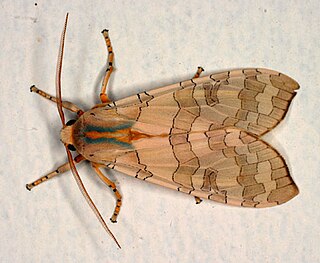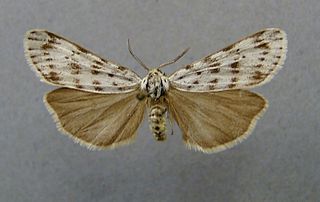Related Research Articles

The Arctiinae are a large and diverse subfamily of moths with around 11,000 species found all over the world, including 6,000 neotropical species. This subfamily includes the groups commonly known as tiger moths, which usually have bright colours, footmen, which are usually much drabber, lichen moths, and wasp moths. Many species have "hairy" caterpillars that are popularly known as woolly bears or woolly worms. The scientific name Arctiinae refers to this hairiness. Some species within the Arctiinae have the word "tussock"' in their common names because they have been misidentified as members of the Lymantriinae subfamily based on the characteristics of the larvae.

Noctuoidea is the superfamily of noctuid or "owlet" moths, and has more than 70,000 described species, the largest number of any Lepidopteran superfamily. Its classification has not yet reached a satisfactory or stable state. Since the end of the 20th century, increasing availability of molecular phylogenetic data for this hugely successful radiation has led to several competing proposals for a taxonomic arrangement that correctly represents the relationships between the major lineages.

The Arctiini are a tribe of tiger moths in the family Erebidae.

The Phaegopterina are a subtribe of tiger moths in the tribe Arctiini, which is part of the family Erebidae. The subtribe was described by William Forsell Kirby in 1892. 469 species of Phaegopterina are present and 52 that are recently discovered in Brazil.

The Callimorphina are a subtribe of woolly bear moths in the family Erebidae. The subtribe was described by Francis Walker in 1865. Many of these moths are easily confused with butterflies, being quite brightly colored and somewhat diurnal. Their antennae are not thickened into "clubs", which is a typical characteristic of butterflies.
This is a list of the 109 cartoons of the Popeye the Sailor film series produced by Fleischer Studios for Paramount Pictures from 1933 to 1942.
This is a list of the 122 cartoons of the Popeye the Sailor film series produced by Famous Studios for Paramount Pictures from 1942 to 1957, with 14 in black-and-white and 108 in color. These cartoons were produced after Paramount took ownership of Fleischer Studios, which originated the Popeye series in 1933.
Dolgoma is a genus of moths in the family Erebidae. The genus was erected by Frederic Moore in 1878.

Miltochrista is a genus of moths of the family Erebidae, subfamily Arctiinae. The genus was erected by Jacob Hübner in 1819.

Coscinia cribraria, the speckled footman, is a species of moth belonging to the subfamily Arctiinae within the large family Erebidae. This moth has a widespread distribution in the Palearctic.
Myserla is a monotypic moth genus in the subfamily Arctiinae. Its only species, Myserla transversa, is found in Brazil. The species was first described as Sermyla transversa by Francis Walker in 1854. The genus name Sermyla was replaced by Myserla in 2017, as the former name was a junior homonym of a gastropod genus described earlier in 1854.
Sicciaemorpha is a genus of moths in the subfamily Arctiinae. It contains seven species, which are found in eastern Asia.
Radiarctia is a genus of moths in the family Erebidae from Afrotropics.
The Reptile Database is a scientific database that collects taxonomic information on all living reptile species. The database focuses on species and has entries for all currently recognized ~14,000 species and their subspecies, although there is usually a lag time of up to a few months before newly described species become available online. The database collects scientific and common names, synonyms, literature references, distribution information, type information, etymology, and other taxonomically relevant information.
Stygarctus is a genus of tardigrades in the family Stygarctidae. It was named by Erich Schulz in 1951. The name is a combination of Greek Styx and arktos ("bear").

Callide is a rural town and locality in the Shire of Banana, Queensland, Australia. In the 2021 census, the locality of Callide had a population of 80 people.
Oxyina is a genus of grasshoppers in the subfamily Oxyinae. Current species records are from Pakistan, China, and Java.
Dakenba is a rural locality in the Shire of Banana, Queensland, Australia. In the 2021 census, Dakenba had a population of 127 people.

Stygarctus keralensis is a species of marine tardigrade. It is described from the intertidal area of Vadakara beach, Kerala it can be easily differentiated from closely related species S. gourbaultae. This species was described by groups of researchers namely N.K. Vishnudattan, S. Bijoy Nandan and P.R. Jayachandran of Cochin University of Science and Technology, Kerala, India and J.G. Hansen of University of Copenhagen, Denmark. This species has been named after "Kerala State" situated in the south west coast of India where this species live. The present discovery is an outcome of an ongoing Ministry of Earth Sciences-National Centre for Earth Science Studies study on the ecology and diversity of submarine groundwater habitats of Kerala led by Sivasankaran Bijoy Nandan.

Cyana bianca is a moth species in the subfamily Arctiinae and tribe Lithosiini. It is found from India to Indochina and consists of a species complex.
References
- ↑ Volynkin, Anton; Černý, Karel (11 June 2021). "Taxonomic review of the genus Sicciaemorpha van Eecke (Lepidoptera: Erebidae: Arctiinae), with descriptions of six new species from Malaysia and the Philippines". Zootaxa. 4985. doi:10.11646/ZOOTAXA.4985.1.3 . Retrieved 26 June 2021.